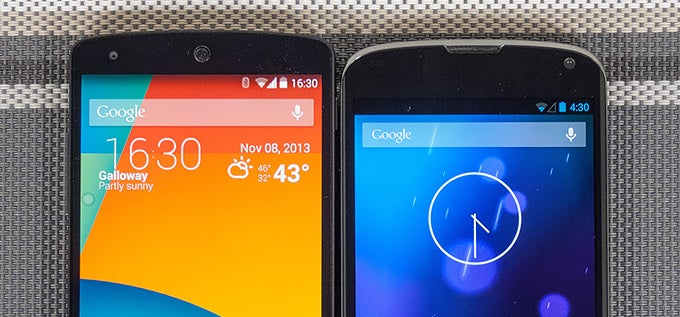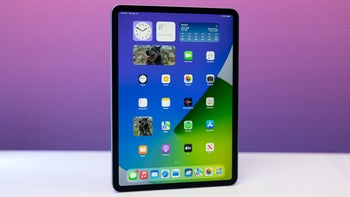Google Nexus 5 vs Google Nexus 4

Introduction
For the past two years LG's flagship announcement has carried some extra weight, because while last year’s Optimus G and this year’s G2 were wonderful phones in their own right, they were also the starting point for the year’s Nexus phone. With increasingly good internals, a rock bottom price point and the promise of a new version of Android, Google is quickly making the Nexus one of the most anticipated devices. Last year’s Nexus 4 was met with critical and user acclaim alike, but there were some shortcomings such as the camera and battery. Can the Nexus 5 put these criticisms to rest, and is the latest Nexus device worth the upgrade from a Nexus 4 that still has a lot of life left in it? Read on to find out...
Design
While the footprint may have been different, the Nexus 4 is a very obvious variant of the LG Optimus G. The back is a dead give away, employing LG’s Crystal Reflective Process which gives the glass a holographic, almost 3D look when the light catches it. It is a very striking design element and really set the Optimus G and Nexus 4 apart from other devices on the market. The sides are coated in soft touch to add grip, and they slope sharply towards the back to give the Nexus 4 better ergonomics in the hand. The button and port layout is fairly standard, as is the camera and speaker placement on the back of the device. The Nexus 4 brought back a premium feel to the Nexus line that went missing in the Samsung days. There was a very obvious focus on the design and the materials of the device, and the Nexus 4 is still a wonderful device to hold and use.
While they share internals, the Nexus 5 takes a very different aesthetic approach than the G2. The latest Nexus has a smaller 5” screen (5.2” for the LG) but opts for a traditional button layout and uses different materials. LG turned to glossy plastic housing with the G2, and while the Nexus 5 also features plastic throughout it is coated in a soft touch finish. The finish on the black version feels just rubbery enough with plenty of grip, while the white is more akin to the “silky” description Google used and leaves a bit to be desired. Both look modest compared to the Nexus 4 and other rival flagship phones, however, build quality is excellent and there are no creaks to be found here.
The liberal use of plastic makes the Nexus 5 noticeably lighter in the hand than the Nexus 4, despite the slightly larger dimensions. It feels very good in the hands and is a comfortable device to hold and use. Another welcome change is the speaker placement, which is now on the bottom of the phone making it less likely to be covered.
Display
A perplexing issue with the Nexus 4 was that the 4.7” 720p display was just not as bright or vibrant as the same one on the Optimus G. The Nexus 5 does not share a display with the G2, opting for a slightly smaller 4.95” 1080p panel that thankfully is every bit as crisp and vibrant as the excellent G2. Another notable difference is that the Nexus 5 is using Gorilla Glass 3, whereas the Nexus 4 uses iteration 2 of Corning’s glass. The side bezels on both Nexus phones are very slim, but the gentle rounding along the edges of the Nexus 4 display unfortunately do not carry over to the latest Nexus.
The Nexus 5 is a clear winner in this category, as the display is simply better all around. In addition to being more vibrant, the bump in resolution coupled with only a slight bump in size gives the Nexus 5 a ppi advantage of 318 to 445. Both displays panels are IPS, giving excellent viewing angles and making them fairly easy to read in most any lighting conditions. Simply put, the Nexus 5 has outdone the Nexus 4 in the display category.
Google Nexus 5 360-Degrees View
Google Nexus 4 360-Degrees View
Interface
We will be brief here, because all Nexus devices run stock versions of Android. While the Nexus 4 currently is still running Android 4.3, we expect an upgrade to the latest version really any week now.
The always listening feature of the Moto X has been implemented to an extent in the Nexus 5. Unfortunately it is only “awake” while you are in the launcher, but simply say “OK Google” and the phone is listening for your command. The feature works excellent, but we’d have preferred it to be implemented as in the Moto X, making it truly hands-free for initiating navigation, starting your music or dictating a text message while driving. This trick will not make its way to the Nexus 4, as the required hardware is embedded into the Snapdragon 800 but not the S4 Pro, so even after the Nexus 4’s KitKat upgrade the Nexus 5 will have this slight advantage thanks to its hardware.
Processor and Memory
Just like the Nexus 4, the Nexus 5 features the best processor the market has to offer at launch. Last year that was Qualcomm’s quad-core Snapdragon S4 Pro clocked at 1.5GHz, this year it is the quad-core Snapdragon 800 running at 2.3GHz. Both phones feature 2GB of RAM, but the Nexus 5 utilizes faster DDR3 versus last year’s Nexus 4 using DDR2. The graphics chip has been updated from the Adreno 320 to the 330, and base memory begins at 16GB, with an option for 32GB with the Nexus 5. Last year your options were 8 or 16GB, and neither device has expandable memory.
All of these hardware upgrades make the Nexus 5 one of the fastest phones we’ve ever used, and one of the best mobile gaming devices on the market. The Nexus 4 is still quick, and will likely get quicker due to the software optimizations made in Android 4.4, but the Nexus 5 outperforms it in every benchmark test we run as well as in real world usage and we don’t expect that to change. That said, we aren’t noticing any lag in day to day use with the Nexus 4 so you’ll still have a good experience with the older Nexus if you choose to eschew an upgrade.
Internet and Connectivity
The big story here is two-fold. First, out of the box the Nexus 5 supports LTE. The Nexus 4 didn’t officially support LTE at all, although with a little hackery you could get it up and running on band 4, used by T-Mobile USA. Secondly, the North American Nexus 5 supports both GSM and CDMA networks, while the other Nexus 5 variant covers most of the rest of the world.
The North American version of the Nexus 5 (D820) supports LTE on bands 1, 2,4,5, 17, 19, 25, 26 and 41, GSM 850, 900, 1800 and 1900MHz, WCDMA bands 1, 2, 4, 5, 6, 8 and 19 and CDMA band class 0, 1 and 10. For US users, that means the Nexus 5 will work on AT&T, Sprint and T-Mobile’s 2, 3 and 4G networks, and should be compatible with any of their prepaid subsidiaries. It will also support Sprint’s new Spark Network. Noticeably absent is Verizon support, but 3 carriers and LTE is better than 2 and none.
The D821 variant has no CDMA support, and supports LTE bands 1, 3, 5, 7, 8 and 20 and WCDMA bands 1, 2, 4, 5, 6 and 8 which gives it almost universal coverage in Europe and the rest of the world, save for Asia and it’s hodgepodge of wireless technologies. There may various other carriers that can’t support either the D820 or D821, but in general if you’re not in Asia there is a Nexus 5 for you.
Web performance is not surprisingly similar between the two devices. While you’re going to get faster page loads on the Nexus 5 while on cellular date (assuming you have LTE coverage), rendering in the stock Chrome browser is nearly identical.
Camera
A low point of the Nexus 4, Google and LG have obviously put significant work into the Nexus 5’s shooter. We did not see a sensor bump from 8MP, but everything else is vastly improved starting with optical image stabilization. To keep it brief, the Nexus 5 outperforms its predecessor in every aspect of camera performance and the results speak for themselves. Colors are brighter, detail is crisper, noise is lower and focus is sharp.
While both devices record video at 1080p, the results were more of the same. The Nexus 5’s optical image stabilization really stood out by making the video much less jerky than the Nexus 4. Colors and details were again better, and mic pickup was better almost to a fault. Sounds were slightly robotic on the Nexus 4 and more natural on the Nexus 5, but the latter device picked up too much background and wind noise. Hopefully this is something that can be addressed in a software update.
Multimedia
As both devices run stock Android the multimedia experience is similar but there are some differences. KitKat has a new feature that detects if a device has a dedicated audio processor (the Nexus 5 does) and uses that instead of the standard application processor which drastically improves battery life. Google claims that the Nexus 5 can deliver 60 hours of music playback. The Nexus 5’s larger and better display will deliver a better video experience than the Nexus 4. The interface for audio, video and the like are basically identical between the two Nexus devices, and while there may not be support for all codecs out of the box there are plenty of apps available in the Play Store that can play what you want.
Call Quality
Callers were impressed with both the Nexus 4 and Nexus 5, but said that the older device was the better of the two. While we came through clearly on both phones, the Nexus 4 had more volume to it and was clearer than the Nexus 5, which had a slight muffle to it according to callers. There was an imperceptible difference in call quality on our end, with both devices delivering warm, natural voice tones but lacking on volume in the loudest environments.
Battery Life
Though the Nexus 5 only adds 200mAh to the Nexus 4’s 2100mAh battery, results are so far much better. The Nexus 5 sleeps very efficiently, draining just over 1% an hour with no use and good network coverage, but processor and/or screen intensive activities will predictably deplete the battery life rapidly. The battery is fixed, meaning that if you run out of juice you’ll have to find a charger. Thankfully, like its predecessor the Nexus 5 supports Qi wireless charging so it is easy enough to top off the device simply by setting it down.
Conclusion
The Nexus phones have always served to showcase the new version of Android they ship with, but starting with the Nexus 4, Google renewed emphasis on the hardware to match the increasingly polished software.
In the end the Nexus 5 delivers an upgrade to the Nexus 4 in just about every area. The screen is improved, the camera is much better, the build is better (while the look is modest) and the user experience is enhanced. The Nexus 5 is a worthy successor, and at a very reasonable starting price it is hard not to justify upgrading your Nexus 4 for Google’s latest Android reference.
Google Nexus 5:
Build number: KRT16M
Android 4.4 KitKat
Google Nexus 4:
Build number: JWR66Y
Android 4.3 Jelly Bean























Things that are NOT allowed: